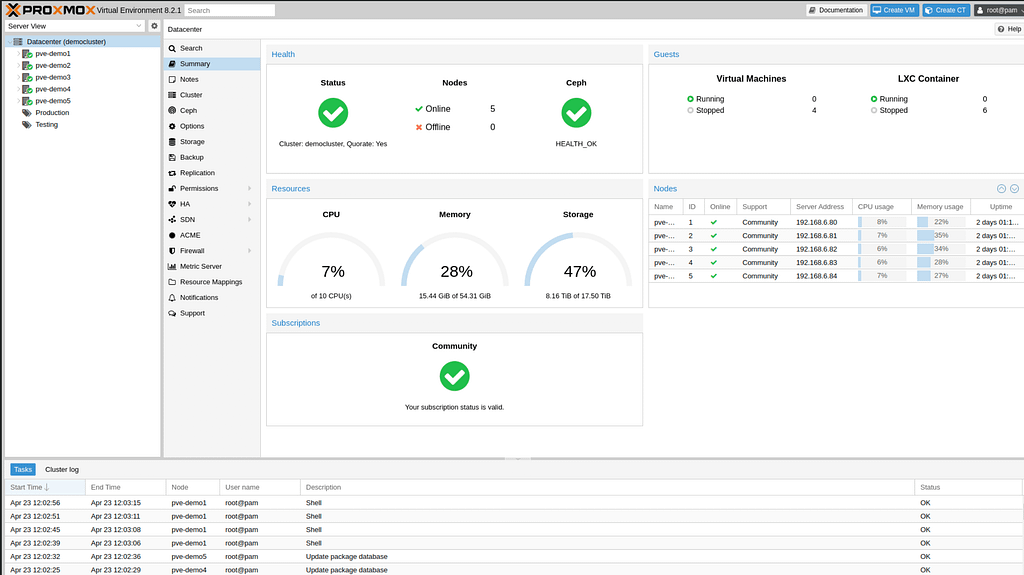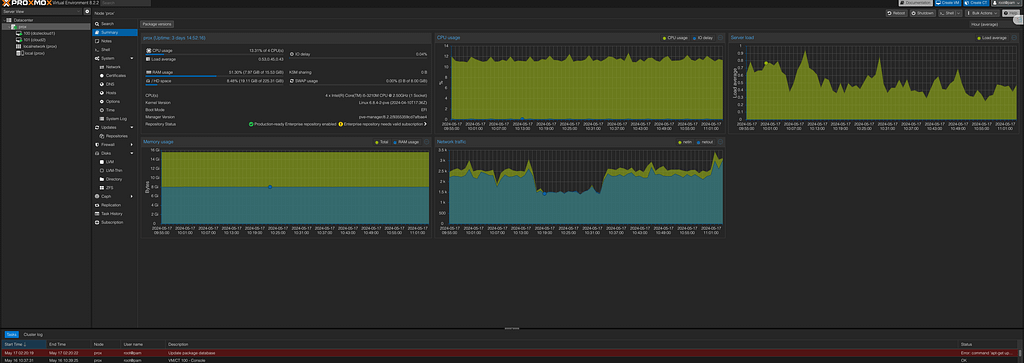Proxmox: The Master Chef of Virtualization
 Chidozie C. Okafor
Chidozie C. Okafor
The ultimate purpose of Proxmox, an open-source server virtualization management software platform, is to simplify the process of creating, operating, and maintaining virtual machines and containers. Using both the LXC and KVM technologies, Proxmox is a full-fledged virtualization platform linked in a single well-designed web interface.
Key Components of Proxmox
- Proxmox Virtual Environment (Proxmox VE): This is the main product, providing a robust environment for deploying and managing VMs and containers.
- KVM (Kernel-based Virtual Machine): A full virtualization solution that allows you to run multiple operating systems on the same hardware, similar to VMware or Hyper-V.
- LXC (Linux Containers): A lightweight virtualization solution that uses containers to run multiple isolated Linux systems on a single host, similar to Docker but integrated at the OS level.
- Web-Based Management Interface: An intuitive interface that allows administrators to manage VMs, containers, storage, and networking from a single pane of glass.
We own a restaurant ( because I love food ), where maximisation of resources, client satisfaction, and efficiency are critical. We have multiple dishes that need to be served at the same time in our kitchen, each with its own components and preparation methods. In order to make sure that everything in our restaurant runs properly, Proxmox steps in as your master chef in this situation. We’ll look at how Proxmox, maintains the ideal equilibrium in our IT infrastructure in this post, making virtualization effective and controllable.
The Kitchen: Understanding Virtualization
Prior to delving into Proxmox, let us first clarify what virtualization is. Virtualization is comparable to a well-organized kitchen where several dishes are being cooked at once in our restaurant. The kitchen is a representation of the actual hardware, and each dish is an operating system (OS).
The Need for Virtualization
Think of our classic restaurant where every dish is made in a separate kitchen. This arrangement is wasteful and ineffective. Similar to this, underutilised resources occur in a data centre when a single server is assigned to every application. Virtualization maximises resource utilisation and lowers costs by enabling multiple applications to share a single server.
Proxmox: Your Master Chef
Let us now present Proxmox Virtual Environment (VE), our hero. Imagine Proxmox as our head chef, supervising all the activities in our kitchen. Proxmox VE is an open-source server virtualization management tool which combines the capabilities of Linux containers (LXC) and kernel-based virtual machines (KVM).
Key Features of Proxmox VE
- Integrated Management Interface: Proxmox offers a web-based interface, like the master chef’s control panel, making it easy to manage VMs, storage, and networks from a single point.
- High Availability: Ensures that our critical “dishes” (VMs) are always served, even if a “kitchen station” (node) fails.
- Live Migration: Move running VMs from one physical host to another without downtime, like seamlessly shifting a dish from one cook to another without disrupting the flow.
- Backup and Restore: Built-in tools for VM backup and restoration, ensuring that our recipes (data) are always safe.
- Flexible Storage Options: Supports various storage types, including local storage, NFS, iSCSI, and Ceph, akin to having a versatile pantry stocked with diverse ingredients.
Proxmox vs. VMware
Let’s contrast Proxmox with VMware, another well-known virtualization software, to better appreciate its advantages. Although Proxmox and VMware both provide reliable virtualization technologies, there are some important distinctions:
- Cost: VMware requires a licence, which can be expensive, similar to employing a high-end chef, but Proxmox is open-source and free, like a gifted volunteer chef.
- Community Support: Similar to a network of seasoned chefs sharing trade secrets, Proxmox boasts a robust open-source community that offers copious documentation and support. Since VMware is a commercial product, expert help is available for a fee.
- Ease of Use: While VMware’s interface can be more complex and require specialised training, much like learning a difficult cooking method, Proxmox’s web-based interface is easy to use and intuitive.
Comparing Proxmox to Other Open-Source Solutions:
Proxmox vs. OpenStack
OpenStack is a well-liked open-source cloud computing platform. Proxmox and OpenStack both provide virtualization, however they serve distinct purposes:
- Complexity: Proxmox is perfect for small to medium-sized deployments because it is simpler to set up and maintain. Comparing OpenStack to a large-scale catering operation would be like comparing a well-managed kitchen to an expansive cloud environment. OpenStack, on the other hand, is more complex.
- Use Case: OpenStack is superior at creating private and public clouds, similar to running a single restaurant as opposed to a chain of restaurants, while Proxmox is ideal for classic virtualization and containerisation.
Proxmox vs. Docker
Applications can be packaged into containers using Docker, a platform for containerisation. While Docker focuses primarily on application-level isolation, Proxmox also supports containers via LXC. This is how they contrast:
- Scope: Docker just focuses on containers, whereas Proxmox offers a full virtualization solution that includes VMs and containers. It’s like comparing a food truck with a full-service kitchen that serves only one kind of food.
- Integration: Proxmox offers you the best of both worlds with its ability to run Docker containers within virtual machines (VMs). This is similar to a chef who can produce both elaborate feasts and short nibbles.
The Future of Proxmox
Like technology, Proxmox is always changing. The development team makes sure Proxmox stays a leading virtualization option by consistently adding new features and enhancements. Like a great chef always honing his culinary talents to keep ahead of trends, Proxmox is well-positioned to adapt and thrive with the rise of edge computing and hybrid cloud solutions.
Proxmox is the master chef of IT infrastructure, creating a virtual environment that is both harmonious and productive. Because to Proxmox’s strong feature set, intuitive web interface, and potent mix of KVM and LXC, virtualization is now affordable and doable for companies of all kinds.
Let’s now discuss the reasons you might want to reconsider how dependent you are on the cloud. Just like eating out every night can easily empty your bank account, using cloud apps on a regular basis might result in growing expenses. Generally speaking, hosting fees, data transfer fees, and storage costs can add up even for little applications.
Imagine using Proxmox to transform an outdated laptop into a terrifying server. To further reduce costs, you might use your current gear rather than paying a cloud service monthly fees. With Proxmox, your outdated laptop may be transformed into a strong, multifunctional server that can run numerous virtual machines (VMs) and containers, providing dependable and effective client service.
Running multiple ubuntu instances in my 2013 MacBook Pro, 256 gig ssd, corei5 and 16gig ram

So why not maximise your resources, cut expenses, and regain control over your IT infrastructure? Proxmox gives you the ability to accomplish this, transforming each piece of hardware into an invaluable tool for your virtualization kitchen. It’s time to use Proxmox to bring your apps home, make the most of your resources, and prepare a successful meal.

Subscribe to my newsletter
Read articles from Chidozie C. Okafor directly inside your inbox. Subscribe to the newsletter, and don't miss out.
Written by

Chidozie C. Okafor
Chidozie C. Okafor
With a sparkling five years of experience, I've triumphed in both web and mobile development, feasting on a banquet of front-end and back-end technologies. Picture me as a tech aficionado, devouring new frameworks and skills at lightning speed – "Hello, World!" can hardly keep up! As an open-minded and ever-curious adventurer, I'm always eager for fresh experiences, striving to forge a fulfilling and thrilling career in software development. Through hands-on practice, I continuously refine my development techniques, transforming each challenge into a chance to learn and flourish. Dedication and drive fuel my every project, guaranteeing unparalleled success for the organization. With a perfect blend of professionalism and charisma, I create a captivating presence that's simply irresistible. So, let's join forces and embark on this exhilarating journey together! My toolbox is brimming with Python (Django and FastAPI), TypeScript (Node and Express), Golang, Kafka, GRPC, REST, GraphQL, and a plethora of cloud technologies. Delighted to contribute as both a backend developer and a DevOps engineer, I'm the versatile team player you've been searching for. A swift learner, I dedicate my time to mastering skills that streamline the job without compromising efficiency. As part of your team, you'll gain a well-rounded, imaginative powerhouse committed to meeting deadlines and exceeding expectations. Let's get started! 🌟